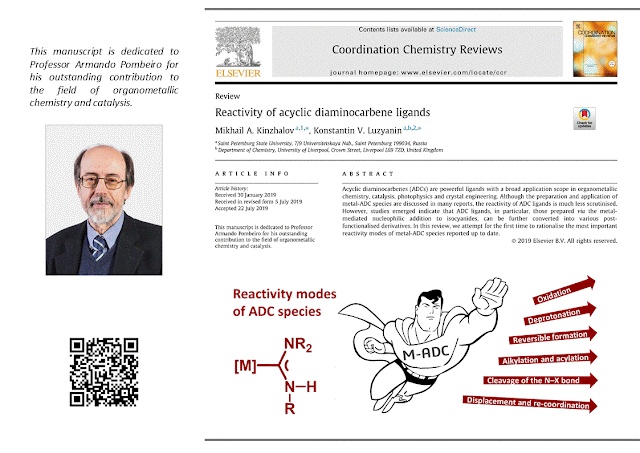Tetrazol-5-ylidene Gold(III) Complexes
Tetrazol-5-ylidene Gold(III) Complexes from Sequential [2 + 3] Cycloaddition of Azide to Metal-Bound Isocyanides and N4 Alkylation
Full text: Organometallics, 2017, 36, 3974–3980
We established that gold(III)
complexes with rare NHC species, i.e. 1,4-disubstituted tetrazol-5-ylidenes, can
be accessed directly from gold(III)-isocyanides. Herein, the [2 + 3] cycloaddition
between equimolar amounts of the isocyanide complexes [AuCl3(CNR)]
and tetrabutylammonium azide furnished the corresponding tetrazolate derivatives
[n-Bu4N][AuCl3(CN4R)]
in good to excellent yield.
This reaction is gold(III)-mediated insofar as no
reaction between free azide and uncomplexed isocyanide was observed. Results of
DFT calculations for a model system reveal that the mechanism for the
cycloaddition of an azide to the isocyanide ligand in [AuCl3(CNMe)]
is stepwise and involves nucleophilic attack of N3– on
the N atom of CNMe followed by ring-closure. The addition is both kinetically
and thermodynamically favorable and occurs via the formation of an acyclic
NNNCN-intermediate, whereas the cyclization is the rate-determining step.
 |
| Proposed
stepwise (A and C) and concerted (B) mechanisms for the
formal CA of N3– to [AuCl3(CNMe)] |
In
the next step, selective N4-methylation of [n-Bu4N][AuCl3(CN4R)]
with equimolar amount of MeOTf leads to the corresponding gold(III) complexes
with 1,4-disubstituted
tetrazol-5-ylidene carbene ligands, that were obtained in good yield
after purification.
 |
| N4-alkylation leading to gold(III)-complexes with 1,4-disubstituted tetrazol-5-ylidenes |
With a representative example we demonstrated that the sequence of cycloaddition/alkylation can be undertaken in one-pot manner without the separation of intermediate compounds [n-Bu4N][AuCl3(CN4R)] giving target gold(III)-NHCs in yields comparable to the sequential procedure. A sequence of gold(III)-mediated [2 + 3] cycloaddition between isocyanide and azide followed by the N4-methylation of the intermediate tetrazolate formed represents a unique approach to gold(III) complexes with 1,4-disubstituted tetrazol-5-ylidene carbene ligands that can hardly be accessed by other routes. Further studies aiming at preparation of gold(III)-NHCs via [2 + 3] cycloaddition are underway in our group.






